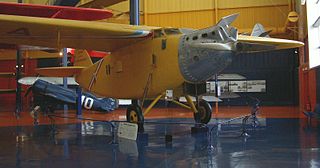
The Bernard 190 or Bernard-Hubert 190 was a French airliner of 1928. It was a high-wing cantilever monoplane of conventional configuration, based on the Bernard 18. Compared with its predecessor, it kept the same basic design but featured redesigned tail surfaces, an enlarged cabin, and offered its flight crew a completely enclosed cockpit. Also like its predecessor, the basic airliner model provided the basis for a long-range aircraft to be used in record attempts, the 191GR.
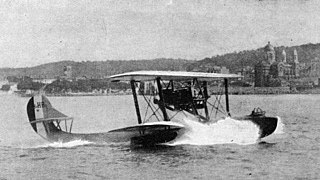
The Blanchard Brd.1 was a French reconnaissance flying boat, to the 1923 STAé HB.3 specification, used by the French navy in the 1920s. It was a large biplane with two engines mounted in the gap between the wings, each engine driving a pusher propeller. In 1924, one Brd.1 was used to set several world altitude records for seaplanes.

The Blériot 127 was a French bomber aircraft of the 1920s and 1930s, developed from the Blériot 117 escort fighter. It was a large monoplane of conventional configuration that featured open gunner's positions in its nose and at the rear of its two underwing engine nacelles. The wing airfoil was of sufficient thickness that these latter positions could be accessed from the fuselage in flight.

The CAMS 37 was a French 1920s biplane flying boat designed for military reconnaissance, but which found use in a wide variety of roles.

The Farman F.120 and its derivatives were a family of multi-engine airliners and bombers of the 1920s built by the Farman Aviation Works in France.

The Dewoitine D.19 was a fighter aircraft built in France in 1925 in response to a French Air Force solicitation.

The FBA 19 was a flying boat bomber developed in France in 1924 by Franco-British Aviation.

The Letord Let.5 was probably the most numerous of a family of 3-seat reconnaissance bombers, designed and built in France from 1916, originally to an A3 specification from the STAé.

The Levasseur PL.5 was a carrier-based fighter produced in France in the late 1920s, in response to the 1924 AMBC.2 specification issued by the Service Technique de l'Aéronautique (STAé). It was a conventional, single-bay sesquiplane that carried a crew of two in tandem, open cockpits. Like other Levasseur naval designs of the day, it incorporated several safety features in case of ditching at sea. Apart from small floats attached directly to the undersides of the lower wing, the main units of the fixed, tail-skid undercarriage could be jettisoned in flight, and the underside of the fuselage was given a boat-like shape and made watertight.

The Levasseur PL.6 C.2, also known as Levasseur VI C.2, was a two-seat fighter aircraft built in France in 1926 in order to meet a 1925 C.2 Service Technique de l'Aéronautique (STAé) specification,. Constructed along the same lines as Levasseur's naval aircraft of the same era, it was a conventional, single-bay biplane with seating for the pilot and tail gunner in separate, open cockpits. Flight testing of the prototype commenced in 1926, and it was exhibited at the Salon de l'Aéronautique at the end of the year.

The Levasseur PL.7 was a torpedo bomber developed in France in the late 1920s. It was a development of Levasseur's PL.4 reconnaissance aircraft and intended to replace their PL.2 then in service with the Aéronavale. It was a single-bay biplane of largely conventional design, but incorporating safety features for naval operation, including jetissonable main undercarriage units, a watertight, boat-shaped fuselage, and small floats on the undersides of the lower wings.

The Levasseur PL.10 was a carrier-based reconnaissance aircraft developed in France in the late 1920s. It was a conventional, single-bay biplane along similar lines to Levasseur's contemporary designs for the French navy, including a watertight, boat-shaped fuselage, small underwing floats, and undercarriage that could be jettisoned in flight in order to improve the changes of a successful ditching.
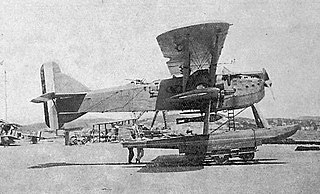
The Levasseur PL.14 was a torpedo bomber seaplane developed in France in the late 1920s. It was essentially similar to Levasseur's PL.7 carrier-based reconnaissance aircraft with the addition of pontoons. The design dispensed with the small underwing floats that formed part of the safety equipment of Levasseur's carrier-based aircraft of the period, but retained the boat-like fuselage. The wing was built to the 18.00-metre design originally developed for the PL.7 but ultimately rejected in favour of a shorter wing.
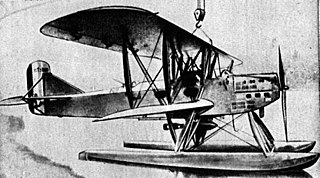
The Levasseur PL.15 was a torpedo bomber seaplane developed in France in the early 1930s. It was a follow-on design to Levasseur's PL.14 that had, in turn, been developed from the carrier-based PL.7. While the PL.14 retained the PL.7's boat-like fuselage, the PL.15 was a purpose-built seaplane with an all-new, slender fuselage.

The Farman NC.470 was a French twin-engined floatplane designed as a crew trainer for the French Navy. It was used in small numbers for both its intended role as a trainer and as a coastal reconnaissance aircraft at the start of World War II.
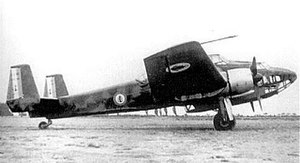
The SNCAO CAO.600 was a French prototype twin-engined torpedo-bomber of the Second World War. It was intended to operate from two new aircraft carriers of the French Navy, but only a single example had been completed and flown when the surrender of France in June 1940 ended development of the aircraft.

The Loire 30 a.k.a.Loire 300 was a French three-seat night reconnaissance monoplane designed and built by Loire Aviation of St. Nazaire.

The Blériot-SPAD S.91 was a French light-weight fighter aircraft. It would be later developed into the Blériot-SPAD S.510, the last biplane produced by the French aeronautic industries.
The Gourdou-Leseurre GL-820 HY family of four-seat single-engined floatplanes were designed and built in France during the latter half of the 1930s by Gourdou-Leseurre. The GL-820 HY and GL-821 HY 02 were shipborne reconnaissance / observation aircraft, while the sole GL-821 HY was built as a torpedo carrier.
The Levasseur PL.3 AM3 was a carrier-based reconnaissance aircraft produced in France in the 1920s to fulfill a specification for a three-seat carrier-borne reconnaissance aircraft. The PL.3 AM3, a biplane of all-wood construction did not enter production and only the prototype was built.



















